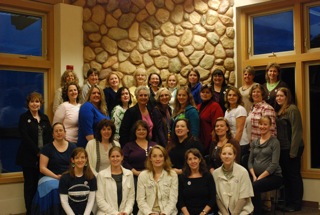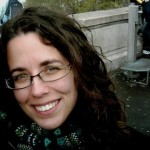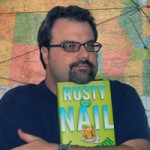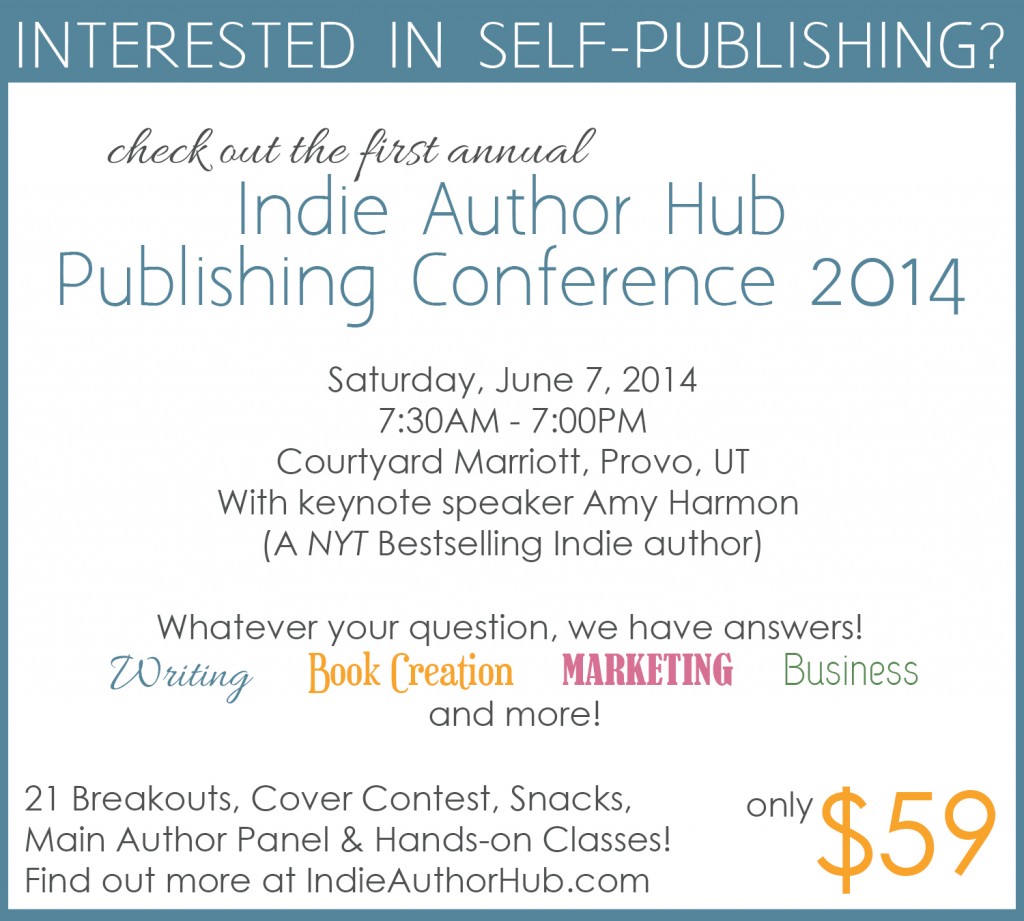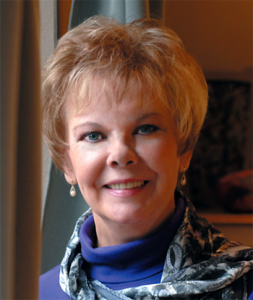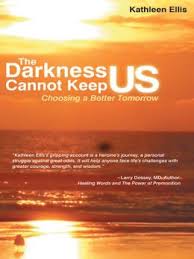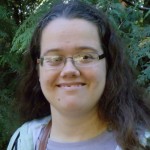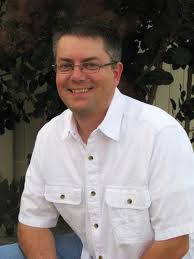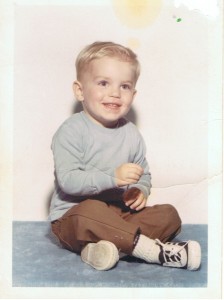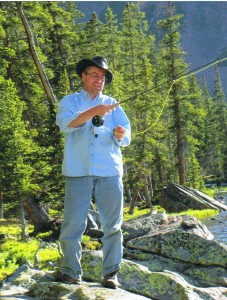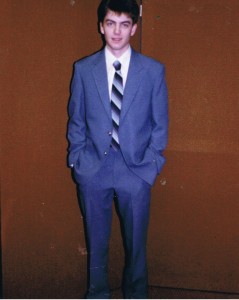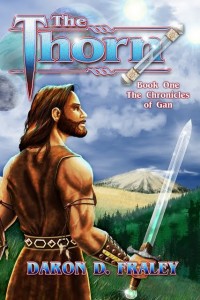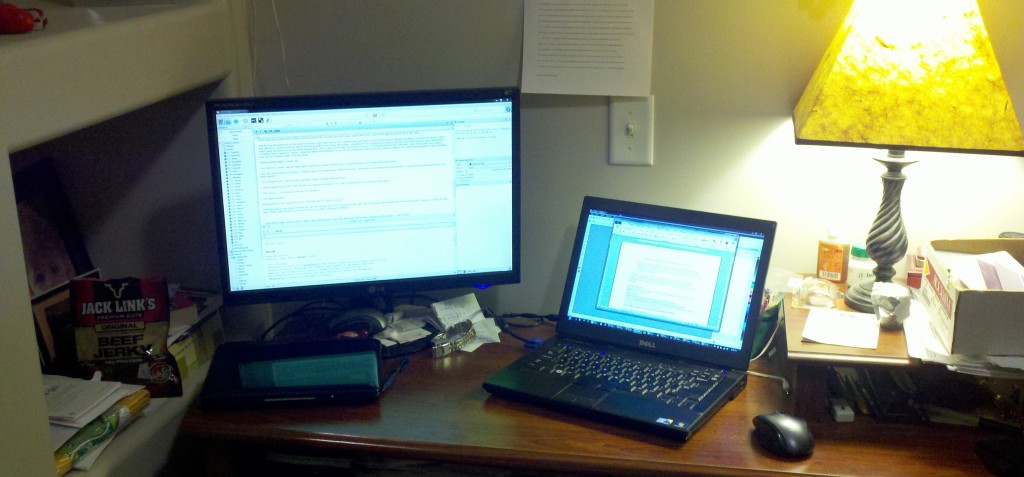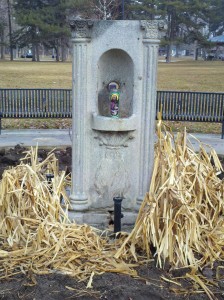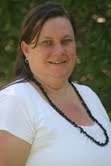I woke up at 4 am for some odd reason this morning, so I’m about ready to keel over right about now (it being 3 in the afternoon). But I cannot give in to a nap, not when that was brought up in my very first question to YA author, Cindy C. Bennett, who has written and published 8 novels, among doing many other things.
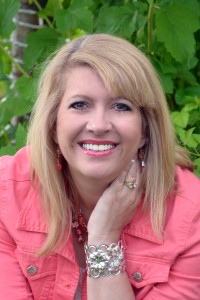 ME: I have to say that, having read your bio on your blog, I am now completely worn out and need a nap. With all that you have going on (several writing projects, critique partners, a new writing business venture, a podcast here and there, etc.), do you ever have time for a nap? Or are you not the napping kind?
ME: I have to say that, having read your bio on your blog, I am now completely worn out and need a nap. With all that you have going on (several writing projects, critique partners, a new writing business venture, a podcast here and there, etc.), do you ever have time for a nap? Or are you not the napping kind?
CINDY: Nap? What’s that? LOL. I do work a lot, so it’s a good thing I love what I do so much. I usually sleep from around 4-6 am until noon or 1 pm. (Talk about a night owl!) So depending on what time I go to bed I might get my full eight, or I might only get five or six hours of sleep. So far it seems to work for me, though.
(I sense an Energizer Bunny…)
ME: In fact, did you nap as a kid? Please tell us what your childhood was like and the kinds of activities you enjoyed most. Did anything hint of a writing future? (I’d love a picture of you as a child.)
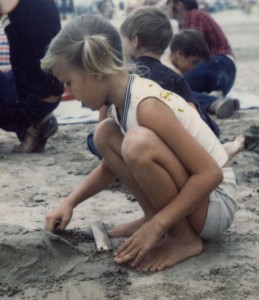 (Cindy at 7…Is that a dragon claw she’s sculpting at the beach?)
(Cindy at 7…Is that a dragon claw she’s sculpting at the beach?)
CINDY: When I was a kid, I played Barbie’s almost obsessively. Looking back now, I can see that it was nothing more than a precursor for writing fiction, as I was making up fictional stories using my dolls. It was my favorite activity until I was deemed “too old” and then I switched my passion to reading. I could read a book a day, especially during the summer when I was out of school.
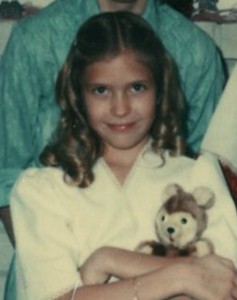
(And here she is at 9…with a teddy bear instead of a Barbie)
ME: You’ve written about how much your high school English teacher, Mr. Bickmore, influenced you with his 10-minute writing assignments. Can you give us the gist of your most memorable piece created from one of those assignments? (Also, I’d love a picture of you in high school, preferably a shot that includes Mr. Bickmore.)
CINDY: I wish I had kept those writing assignments. I didn’t keep any of my schoolwork, other than a story my mom found recently that I wrote when I was 12. It’s so horrible; there’s nothing in it that would indicate any talent for writing, so maybe it’s good I no longer have any of those assignments. I wish I had a picture of me with him as well. I was extremely shy in high school, so it would never have occurred to me to ask him to be in a picture with me. That would be too far outside my comfort zone of the time. He now is a professor at LSU and an editor for The ALAN Review, and I’m in contact with him through the wonderful world of Facebook.
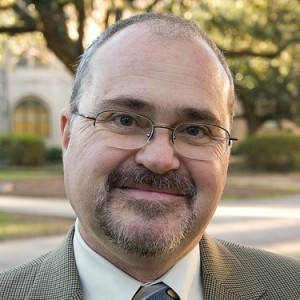 (I used my researching skills to find Mr. Bickmore as he looks today.)
(I used my researching skills to find Mr. Bickmore as he looks today.)
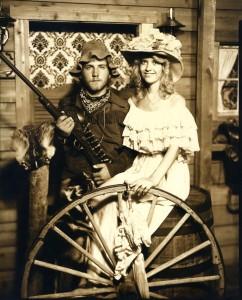 (And here’s Cindy at 16 with a Mountain Man for a date…who ended up marrying her.)
(And here’s Cindy at 16 with a Mountain Man for a date…who ended up marrying her.)
The one of me at age 16 is with my then-boyfriend-now-husband at one of those horrible old fashioned photo places that, I admit, I love. In fact, I made my kids do those almost yearly when they were younger, and which they absolutely hated. Not sure why I like them because, let’s face it, they’re never a good photo.
(Not sure I agree. I think she looks pretty good!)
ME: Did you go to college or go straight into marriage? And since you’re into YA and romance, just exactly how did you meet and fall in love with your husband? Make us swoon, please. :D (Also, a wedding photo would be greatly appreciated.)
CINDY: My husband is my high school sweetheart. We met when I was a freshman and he a sophomore. He’d been dating one of my friends, and she hooked us up because she wanted to date his friend. Sounds like a soap opera, huh? It’s amazing he liked me since I was so severely shy and didn’t talk much. He played football and wrestled and wasn’t at all like the kind of guy I thought I’d fall in love with. But he was sweet, and funny, and fun to be around—and had great arms and a really nice chest (remember, football and wrestling). (It must have been all that bear rasslin’.) We dated all through high school and married a year after I graduated, and we’re still together all these years later.
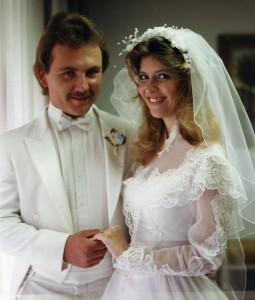 (The promised wedding photo, which she claims reveals a hideous 80s hairdo and a “ragged” look from crying…Say what? Anyway, here’s her preferred engagement photo.)
(The promised wedding photo, which she claims reveals a hideous 80s hairdo and a “ragged” look from crying…Say what? Anyway, here’s her preferred engagement photo.)
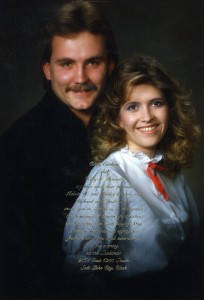
Because I was so silly-in-love with him, I couldn’t wait to be his wife, so rather than go to college, I attended tech school to become a medical assistant. That’s a career pretty distant from writing, other than I did gather a lot of character ideas. I chose that because I’d had major surgery right after high school, and nearly died because of a pulmonary embolism. It was a nurse paying attention to her instincts that saved my life. I wanted to give back the same kind of care, so chose the medical field. I no longer work in the medical field but I miss taking care of patients on a regular basis. There’s something very satisfying in that.
(Okay, the high drama made up for the missing romantic details.)
ME: Please tell us about what impelled you to write your first novel (and provide a cover photo).
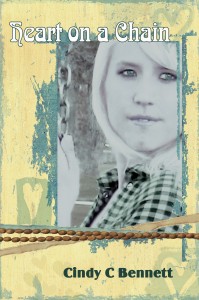 CINDY: There was a girl who lived near our house who was always outside on her swing set. It didn’t matter if it was 100°F outside, or 5°F with a blizzard, she’d be out swinging. In fact, anytime any of us came home we’d report on whether or not she was out. I’d been thinking about her a lot, and wondering what drove her to that swing set. My teen daughter had apparently been thinking along the same lines, so we decided to write a book together. I didn’t admit, even then, that it was my lifelong heart’s desire to be an author. I’d always been afraid of admitting it—and to this day, I don’t know why. Maybe just because it was something I wanted so bad I was afraid if I admitted it I’d have to do something about it and face possible rejection. Anyway, this was a safe way for me to actually complete a manuscript (I’d secretly begun many but never finished one). I wrote the first chapter then handed it off to my daughter to write the second. She liked the first so much she told me to write the second, which I did then gave it back to her. This same pattern continued until she told me just to write the whole thing, which I did. It became HEART ON A CHAIN, which to this day is my bestselling novel.
CINDY: There was a girl who lived near our house who was always outside on her swing set. It didn’t matter if it was 100°F outside, or 5°F with a blizzard, she’d be out swinging. In fact, anytime any of us came home we’d report on whether or not she was out. I’d been thinking about her a lot, and wondering what drove her to that swing set. My teen daughter had apparently been thinking along the same lines, so we decided to write a book together. I didn’t admit, even then, that it was my lifelong heart’s desire to be an author. I’d always been afraid of admitting it—and to this day, I don’t know why. Maybe just because it was something I wanted so bad I was afraid if I admitted it I’d have to do something about it and face possible rejection. Anyway, this was a safe way for me to actually complete a manuscript (I’d secretly begun many but never finished one). I wrote the first chapter then handed it off to my daughter to write the second. She liked the first so much she told me to write the second, which I did then gave it back to her. This same pattern continued until she told me just to write the whole thing, which I did. It became HEART ON A CHAIN, which to this day is my bestselling novel.
(I hope you dedicated the book to her!)
ME: What is your writing process and where do you write? (I must have a photo of your writing space.)
CINDY: It’s odd, I know, but I like to write in my family room, in the middle of life happening around me. That way I don’t feel as guilty spending so much time working because I’m still part of conversations that are happening, still part of the family. I bought a lap desk, and my husband converted it to make it work better for my laptop. I work from the time I get up until I go to bed if I don’t have anything else going on (and my house shows it! I wish I had some mice and/or birds to clean it up for me like Cinderella and Snow White). I do most of my marketing during the day, and then write at night until somewhere between 4-6 am as I mentioned above.
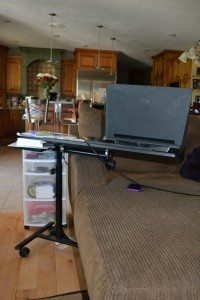 (Her lapdesk…and you’re not going to believe this, but…)
(Her lapdesk…and you’re not going to believe this, but…)
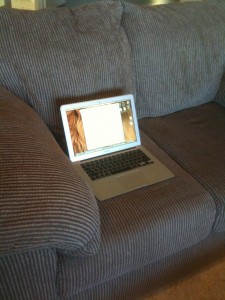
(I have practically the same sofa set in our family room. Comfy, isn’t it, Cindy?)
ME: You have tried both self-publishing and traditional publishing. Which do you prefer and why?
CINDY: There’s something to be said about having an editor who books signings and other events for you, and who can get your book onto shelves at book stores. There’s also something to be said about having complete creative control over your work, and making much higher profits by doing it yourself. I suppose overall I prefer self-publishing because I’m a bit of a control freak, so I do like keeping control over the cover, the book layout, and how and where I can give my books away. And, let’s face it; earning 70% on an eBook is always going to trump 15%. Since you do the same amount of marketing whether you’re traditionally or self-published, it makes the higher profits that much nicer.
ME: What other books have you either published or have waiting in the wings? (I’ll want those cover photos, as well.)
CINDY: After HEART ON A CHAIN came GEEK GIRL, then IMMORTAL MINE. Then I wrote a short vampire story for Noble YA, and they published it as RELUCTANCE.
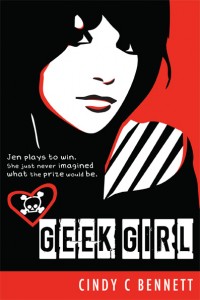
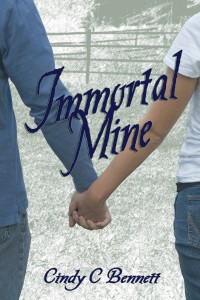
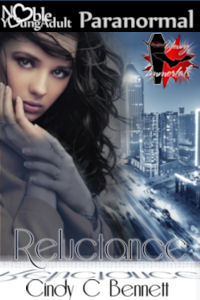 I then published short stories for a couple of anthologies through my company, Prose by Design. Those are IN THE BEGINNING and WATCHED.
I then published short stories for a couple of anthologies through my company, Prose by Design. Those are IN THE BEGINNING and WATCHED.
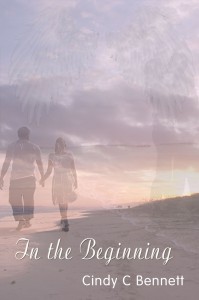
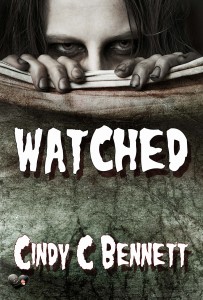 (That cover’s scary!)
(That cover’s scary!)
While writing RAPUNZEL UNTANGLED, which is a modern-day retelling of the story, I published five novellas that are fairytale retellings that now make up ENCHANTED FAIRYTALES, which I recently released. (She’s obviously making up for all those years she shied away from writing.)
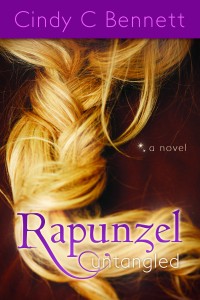
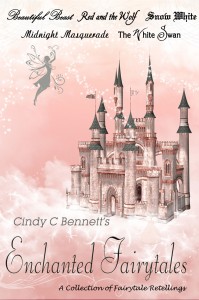 I have upcoming a book I wrote with Jeffery Moore, as yet untitled, but the working title is RAZARI. It’s a sic-fi, which is outside my usual genre, though it’s still a YA. It should be released within the next month. I’m also writing a book, again with Jeffrey Moore and also Sherry Gammon, which we call THE COLLABORATIVE, though that may change as well.
I have upcoming a book I wrote with Jeffery Moore, as yet untitled, but the working title is RAZARI. It’s a sic-fi, which is outside my usual genre, though it’s still a YA. It should be released within the next month. I’m also writing a book, again with Jeffrey Moore and also Sherry Gammon, which we call THE COLLABORATIVE, though that may change as well.
(Are you as impressed reading this as I am just writing it all down?)
It’s kind of cool. The story is about triplets born illegally into a world that only allows a single child per family, so their parents abscond with them to a planet called Senca One, which is where the overpopulated earth has started a new colonization. There, their parents are kidnapped and the triplets search for them, discovering along the way they have hidden abilities.
We are each taking a chapter and writing it from one of the triplets’ POV, so we each have one character to move the story forward. It’s been interesting and fun to write, requiring a lot of talking about how we want things to be and where the story should go.
(I’ll have to keep this in mind for a future posting about writing a series.)
I’m also over halfway finished with another contemporary YA book that’s more like my first few novels. It doesn’t have a title either—I’m really bad at titles so my books usually get them last minute. (Hey, I’d be happy just to match half of your annual output!)
ME: Finally, tell us more about your new writing business and what you offer.
CINDY: Prose by Design is a company I started with Sherry Gammon about a year-and-a-half ago. We’ve recently changed the way we do things. Our intent when we began was to help those who have no idea how to self-publish and market because we were spending so much time helping others anyway. We wanted to do some of the things they might not have the ability to do, such as editing, covers, formatting and layout, and show them the best ways we know how to market.
As it turned out, we were really sort of crippling those authors because we weren’t showing them how to do anything, just doing it for them. So we decided rather than publishing their books and keeping a chunk of the profits, we will instead offer individual services such as those mentioned above. If they want to have to lay out less money in the beginning, we’ll still publish their book and keep a portion of the profits until they’ve paid off their purchased services, at which time ALL rights revert back to them.
We’re also writing a detailed, cohesive book with step-by-step help from writing, to publishing (both self and traditional), including formatting, editing, layout, where to sell your books, how to have a book signing, how to do giveaways, etc. We also have an entire section on marketing which is detailed and will be updatable to those who purchase the book and have signed up for updates. That way, as we discover more marketing strategies, or as things change (as they constantly do), we can keep our readers updated. We’re hoping to have this published by the end of the summer. We’ll also continue to hold writing contests and publish the winners in anthologies. Currently we have a contest for stories for a Christmas themed anthology.
If you haven’t yet checked out Prose by Design, you might want to click on the link. Also, if you want to learn still more about Cindy, check out her website. There, you can find her bio, social media links, and purchasing links for all her books.
Now, I think I’ll take that nap! I need to rest up for next week’s interview with Childrens’ Books author and illustrator, Mikey Brooks.
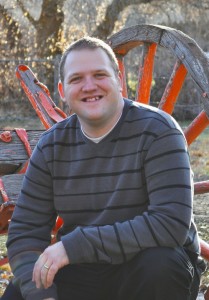
Originally posted 2013-06-05 06:00:59.

